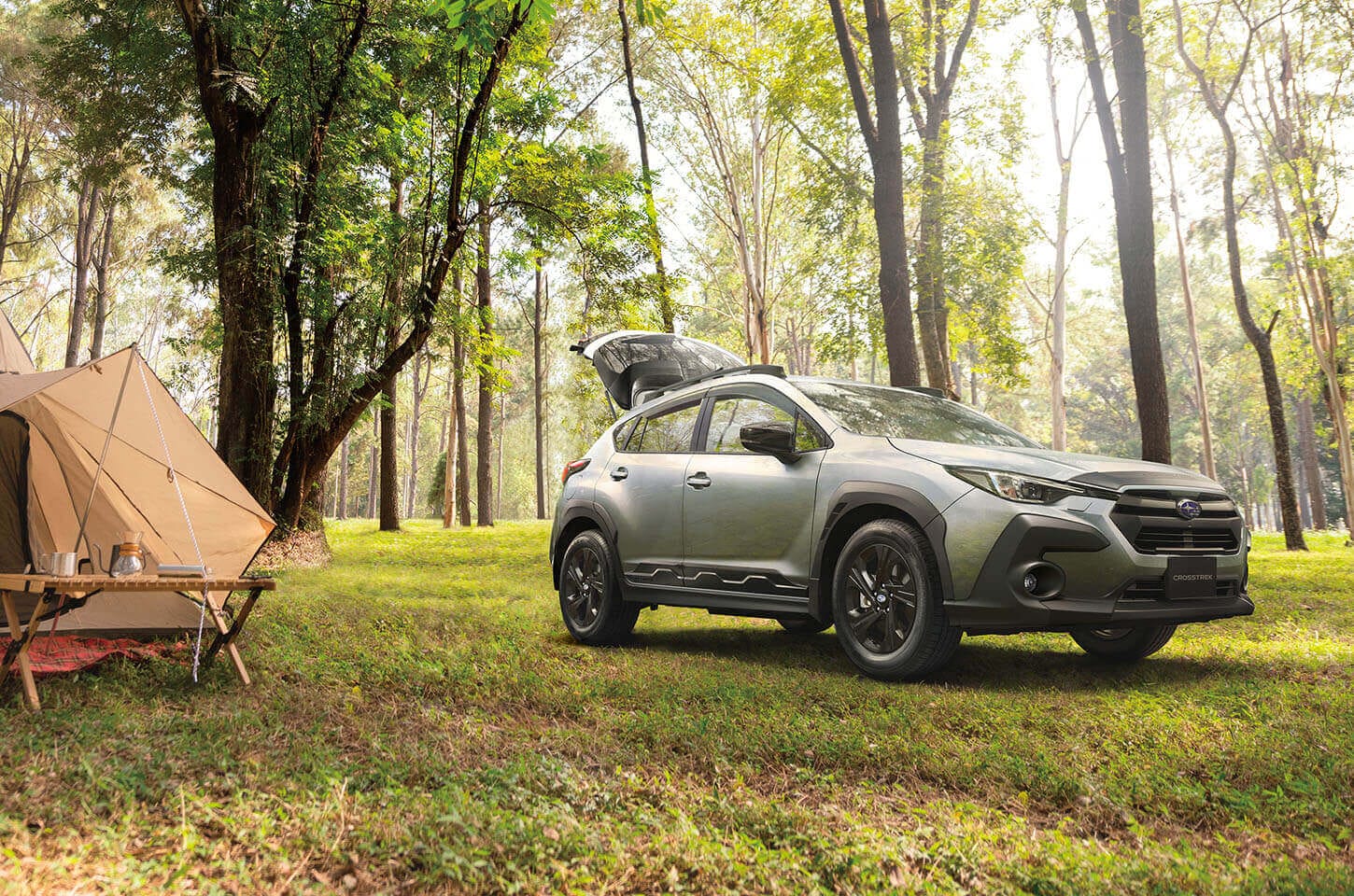When shopping for a vehicle, especially a Subaru, you’ve likely come across terms like AWD (All-Wheel Drive) and 4WD (Four-Wheel Drive). While they might seem interchangeable to the untrained eye, they refer to two distinct systems with unique applications and advantages. Understanding the difference between AWD and 4WD is essential in selecting the right vehicle for your driving needs, especially if you’re navigating varied terrains or weather conditions.
What is an AWD (All-Wheel Drive)?
AWD stands for All-Wheel Drive, a system where power is sent to all four wheels at all times, allowing for better grip and control, particularly on slippery surfaces. Unlike traditional 4WD systems, AWD typically requires no input from the driver—it’s always active and adjusts automatically depending on the conditions.
How does AWD Work?
AWD systems use a centre differential to distribute power between the front and rear wheels. Some systems are biassed towards one axle, like Subaru’s Symmetrical AWD, which splits power more evenly. This system adjusts power to the wheels that need it most, offering seamless transitions on wet, icy, or rough surfaces.
What are the Advantages of AWD?
1. Improved Traction
AWD provides excellent traction, particularly on slippery surfaces like wet roads, snow, or gravel. This makes it an ideal choice for people living in areas with unpredictable weather conditions.
2. Ease of Use
Unlike 4WD, which requires manual activation, AWD systems are usually automatic. Drivers don’t have to engage the system or switch between modes, making it convenient for everyday use.
3. Versatility
AWD systems are perfect for those who drive on paved roads most of the time but want the assurance of extra grip when conditions become challenging.
What is 4WD (Four-Wheel Drive)?
Four-Wheel Drive (4WD) is a system designed for rugged off-road use. It’s typically found in trucks, SUVs, and other vehicles designed for more extreme driving conditions. 4WD systems are usually manual, meaning the driver needs to activate the system when it’s needed, such as during off-road adventures or extreme weather conditions.
How does a 4WD Work?
In a 4WD system, power is delivered to all four wheels, but it’s done through a transfer case that splits power between the front and rear axles. There are usually high and low settings in 4WD vehicles:
- High Range 4WD: This mode is used for normal driving in slippery or rough conditions. It provides extra traction without reducing the vehicle’s speed.
- Low Range 4WD: This is designed for extreme off-road conditions like deep mud, snow, or steep inclines, offering maximum torque to help the vehicle navigate these challenging terrains.
What are the Advantages of 4WD?
1. Superior Off-Road Capability
4WD systems excel in rugged terrains. If you enjoy off-roading or live in areas with rough, unpaved roads, 4WD offers the best performance.
2. Control Over Power Distribution
4WD allows you to manually engage the system, giving you more control when tackling difficult conditions. In low-range mode, you get extra torque, which is critical for steep climbs or towing.
3. Durability
Vehicles equipped with 4WD are often built with heavier-duty components to handle the additional stress of off-road driving.
AWD vs 4WD: Key Differences
AWD (All-Wheel Drive) automatically delivers power to all four wheels for better grip on slippery roads, while 4WD (Four-Wheel Drive) is manually engaged and designed for off-road use, offering more control in rugged terrains. While both AWD and 4WD offer improved traction and control compared to two-wheel drive vehicles, there are some other notable differences that set them apart:
| Features | AWD (All-Wheel Drive) | 4WD (Four-Wheel Drive) |
| Activation | Always active, power sent to all wheels automatically. | Manually activated by the driver when needed. |
| Best Use Case | Ideal for on-road driving, wet or slippery conditions. | Designed for off-road and extreme driving conditions. |
| Terrain Capability | Suitable for light off-road, gravel, snow, and paved roads. | Built for rugged, uneven terrains, like mud, rocks, and deep snow. |
| Power Distribution | Automatically adjusts power between front and rear axles. | Equal power sent to all four wheels when engaged. |
| Vehicle Types | Common in cars, crossovers, and lighter SUVs (e.g., Subaru Crosstrek, Outback) | Typically found in trucks, large SUVs, and dedicated off-road vehicles. |
Which is Better for You: AWD or 4WD?
Choosing between AWD and 4WD largely depends on your driving habits, environment, and what you expect from your vehicle.
Consider an AWD If:
- You mostly drive on paved roads but want added safety during bad weather (rain, snow, or ice).
- You live in urban or suburban areas where off-roading is not a common activity.
- You prefer a system that works automatically without requiring any input.
Consider a 4WD If:
- You regularly drive off-road or live in rural areas with unpaved roads.
- You need a vehicle that can handle steep, uneven terrain, deep snow, or heavy mud.
- You plan to tow heavy loads or require maximum traction for adventures in extreme conditions.
For Subaru enthusiasts, the Symmetrical AWD system offers a balance of performance and safety in nearly all driving conditions. If your lifestyle includes regular off-roading or you live in areas prone to severe weather, a Subaru with AWD can provide you with the versatility and control you need.
AWD vs 4WD: Fuel Efficiency Considerations
Fuel efficiency is a concern for many car buyers, and when comparing AWD and 4WD, there are some important distinctions to keep in mind. Generally, AWD systems are more fuel-efficient because they are lighter and don’t require the heavy-duty components found in 4WD systems. However, the fuel efficiency of both AWD and 4WD systems can vary significantly depending on how and where you drive.
AWD Efficiency
AWD vehicles tend to be more fuel-efficient on paved roads and during everyday driving conditions. Since the system is always on and doesn’t have the heavy low-range gear found in 4WD vehicles, it consumes less fuel overall.
4WD Efficiency
In contrast, 4WD systems, especially when engaged in low-range, use more fuel due to the increased resistance and extra components involved. If you’re driving with 4WD on, particularly in off-road conditions, expect higher fuel consumption.
That said, advances in Subaru’s AWD technology have continued to improve fuel efficiency without sacrificing performance. This makes Subaru’s AWD vehicles a popular choice for drivers seeking a balance of economy and capability.
AWD vs 4WD in Different Weather Conditions
Both AWD and 4WD systems can enhance a vehicle’s performance in poor weather conditions, but they are not equally suited for all environments.
AWD in Bad Weather
AWD shines in everyday driving conditions, especially when rain, light snow, or ice is present. It distributes power to all wheels, ensuring better grip and reducing the chances of slippage.
4WD in Bad Weather
In heavy snow, deep mud, or ice, 4WD offers superior traction. When engaged, it sends equal power to all four wheels, making it easier to navigate through treacherous conditions.
Subaru’s Symmetrical AWD, for instance, provides excellent balance and control in adverse weather, making it a solid choice for drivers who regularly face wet or icy roads.
AWD vs 4WD – What’s the Best Choice?
Choosing between AWD and 4WD depends on your driving habits and the conditions you face. For everyday driving with occasional rough weather or light off-roading, AWD provides the convenience and confidence you need, especially in models like the Subaru Outback and Crosstrek. On the other hand, if you’re regularly driving in extreme off-road conditions, 4WD offers the durability and control required for tougher terrains.
Whether you’re after the smooth versatility of AWD or the rugged performance of 4WD, City Subaru Dealer has a range of vehicles designed to suit your lifestyle. Visit us to explore the latest models, book a test drive, or speak to our team to help you find the perfect Subaru for your needs. Contact us today to start your adventure!


